Fairy Tales & Fables Part 1: Little Red Riding Hood, The Three Billy Goats Gruff, & The Three Little Pigs
There are so many reasons for parents to read fairy tales and fables to young
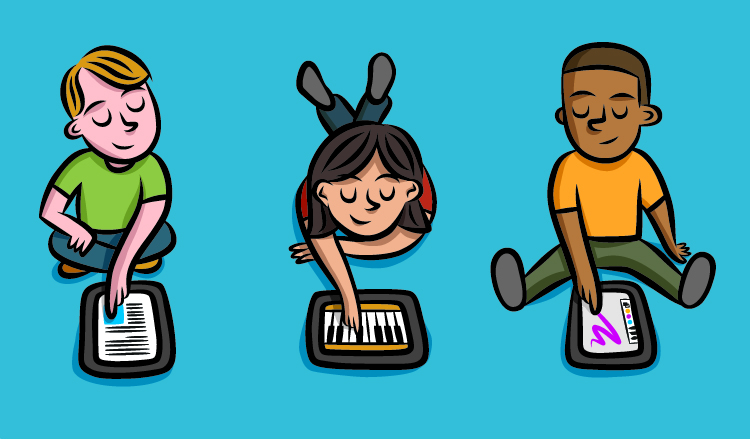
It's become a common New Year's resolution for parents: This year, less screen time.
But it's a promise that's almost impossible to keep, particularly if you are the parent of a child with autism. It's not that our kids are more "addicted" to screens than NT kids; the data doesn't support that pervasive stereotype. But our kids are different. They may stim with screens. Screen time may fill a sensory need. Or, they may simply not know how to engage in other unplugged leisure activities. Abruptly denied their screen, a child may increase or develop new problem behaviors, stim in new ways or more often, or develop new sensory seeking habits.
And what if they don't have enough language to understand an explanation you give about why they can't have their screen time? A child accustomed to a certain level of access may wonder: Am I being punished? For what? On the rare occasions that I have completely denied one of my 5-year-old twin sons, Luke, his daily screen time, he hurriedly cycles through all the verbal mands (requests) he's ever mastered: "I want iPad, please!"—"Can I have the iPad?"—"I want that one, please!" He makes eye contact. He opens his eyes extra wide to emphasize the eye contact. He tries pointing. He tries adding adjectives to his verbal requests. "I want the blue iPad, please!" And as each attempt fails, he grows increasingly frustrated, sad, confused, and (inevitably and understandably) angry.
Autism mom, BCBA-D, and blogger Mary Barbera has similar concerns. In a thought I viscerally relate to in her recent article, Why I Wouldn't Stop Screen Time for Children with Autism, she describes her hesitance to pull the electronics plug:
"If I had my choice between having a child who’s two or three build repetitively, the same thing over and over and over again for an hour, or watch an episode of a children’s TV show, I’d actually pick the screen time because I think there’s more language involved."
Of course, this doesn't mean you shouldn't try to reduce truly out-of-control screen time. (Been there. Done that.) Luke's home-based therapist set up a visual activity schedule to help him move through different kinds of play, which can include his iPad time. We also set timers and allow for "one more minute, please" requests to help with termination. If you think about it, we adults do this for ourselves all the time: Once I do all the dishes, I'm going to lay on that couch and watch something on HBO.
Once you stop beating yourself up for allowing your child to enjoy a screen, you can spend more time thinking about what kind of screen time you want to encourage. I've been on a three-year (and counting) quest always looking for better ways to use screen time to encourage literacy and reading. Here are 6 strategies that have worked for my kids.
The Internet is a very strange place. And YouTube is one of its stranger corners. So it shouldn't shock you to learn that YouTube hosts thousands and thousands of videos of people reading almost every picture book that exists in print in any language.
Watching videos of people reading picture books is how my son Luke really fell in love with the Pete the Cat series.
Here's the video that started it for us, which was posted by YouTube user simicrane (who has been adding dozens of high-quality picture book videos to that channel for over five years). The narrator who reads and sings the book is actually Pete the Cat author Eric Litwin.
I like this use of screen time because it conditions the critically important experience of an adult reading a book aloud to the child by pairing it with something almost universally beloved by screen-obsessed kids: YouTube.
With this experience the child can pause and play the story, go back to hear something again, change the volume, verbalize along with the reading, and move their body however they please. Most of this would not be possible in a real-life storytime, and that is one reason why this makes such good practice for the real thing. My son Luke likes to jump up and down while he watches these videos. He also enjoys hovering the cursor further ahead on the video progress bar so he can see the little preview frames and know what's coming next.
Best of all, you don't have to spend a dime. Simply search YouTube for the titles of all the picture books already in your home, curate a playlist of the best ones, and bookmark it for easy access.
A few weeks ago, when Luke went in for neuropsychological testing, I was shocked to discover that he could spell. This is a kid who can barely string words together unless he really wants to ask for something.
I knew he'd been learning to identify some sight words in his ABA school program, but they hadn't taught spelling. When the evaluator reviewed the words he'd successfully spelled with me, I realized where he'd learned many of them: Endless Alphabet, Endless Reader, and Endless Wordplay—three of his favorite iPad games.
These Luke-approved favorites are all by the same developer, Originator, and the perfect one to start with is Endless Alphabet ($8.99), which features word puzzles of empty silhouettes with letters scattered about. You drag the letters to their gray silhouettes, and the letters (all silly, animated, colorful monsters) make their letter sound as they move. After you complete a word, you are rewarded with a short, very silly animation illustrating the word's definition.
I'm also a huge fan of all the Sesame Street apps, including Elmo Loves ABCs ($4.99); all the Starfall apps, including Starfall ABCs (Free); and all the Bob Books apps, including Bob Books #1 - Reading Magic ($2.99). Starfall and Bob Books aren't as animation-rich as the other two, so YMMV.
E-books should never replace physical books for children. Important tactile considerations aside, kids need lots of physical books in their homes because easy, constant access to a language-rich environment is critical. Books remind you to read partly because they are there. Still, some of the better designed picture book e-books provide a fun interactive experience that can generalize interest in a companion physical book once screen time is "all done." And if reading an e-book is how my kids want to spend their screen time, I'm all for that, with bells on.
The best e-books for kids are really apps, meaning that they have more bells and whistles (games, etc.) built into the stories than a basic e-book does. The ones I like the best are from the Dr. Seuss collection by Oceanhouse Media. This developer takes classics like Green Eggs and Ham and The Lorax and creates interactive e-books that highlight the words as the story is narrated, give kids more when they tap on words and pictures, provide fun in-story easter eggs for kids to discover, and incorporate learning activities and games.
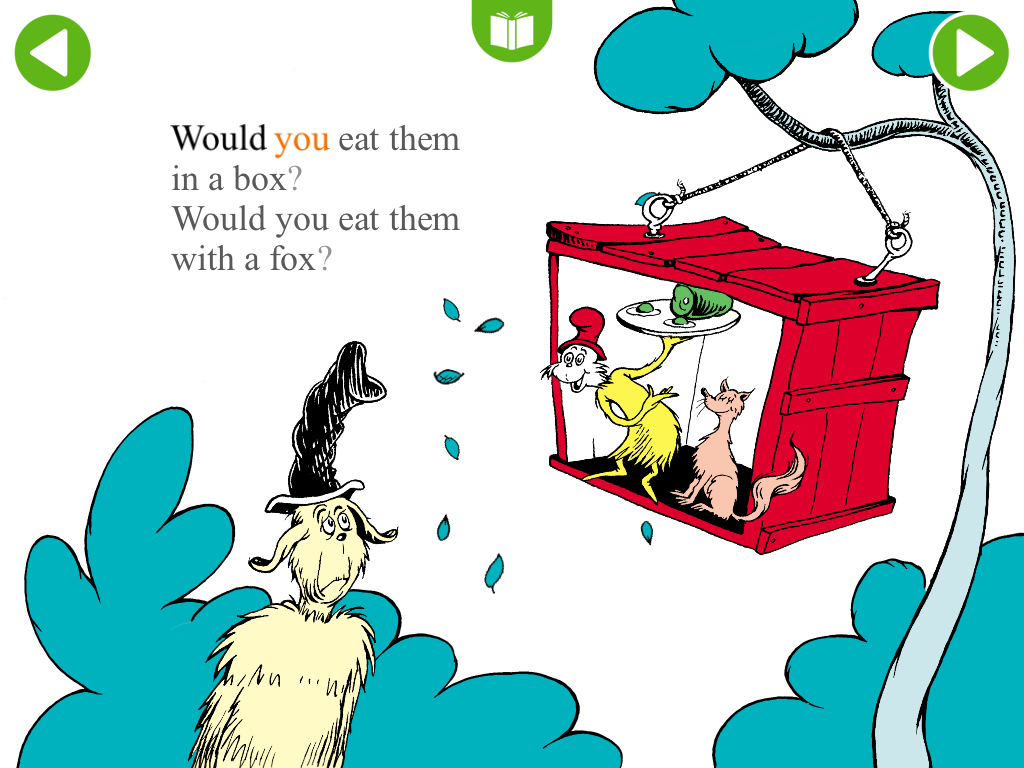
The Dr. Seuss app collection ($3.99/each) includes: The Cat in the Hat, Green Eggs and Ham, Dr. Seuss's ABC, One Fish Two Fish Red Fish Blue Fish, Hop on Pop, Fox in Socks, Mr. Brown Can Moo! Can You?, The Foot Book, How the Grinch Stole Christmas, The Lorax, Oh, The Places You'll Go!, Horton Hears a Who!, and The Sneetches.
An exciting new trend in children's publishing is that some of the best app developers are getting into the kid lit business too. Instead of adapting well-loved classic books, these trailblazers are simultaneously releasing new picture books with companion apps. The company to watch in this category is Nosy Crow, and specifically I'm recommending their Fairy Tales series.
Most fairy tale picture books are too long and complicated for a child with attention issues, and many of the modern cartoons are "updated", twisting the tale in a way that assumes you already know the original—pretty annoying when your kid doesn't. The Nosy Crow series only slightly tweaks the original tales to reduce the violence and update for contemporary details so that the books are more accessible for today's kids. For instance, in The Three Little Pigs one of the brother pigs is now a sister, the Big Bad Wolf drives a truck when he arrives in town, and no one is eaten.
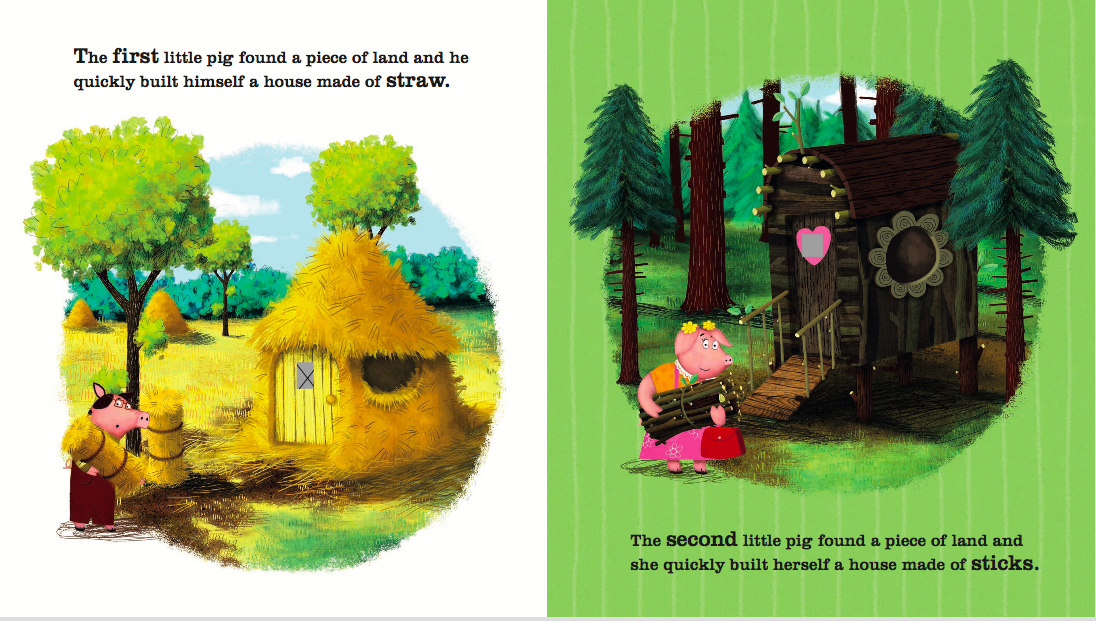
My son Harry, loved these books immediately. The language is spare. The lettering emphasizes sight words. The art is very modern and easy to parse. The stories (as fairy tales should) have a repetitive structure, which is perfect for autistic kids like mine, many of whom feel more comfortable when they can predict what happens next. But despite everything in the plus column, they were too long and difficult for my other son Luke. But that all changed when I downloaded the companion apps.
Nosy Crow's Fairy Tales book series and apps include:
Fairy Tales: Cinderella book and app.
Fairy Tales: Little Red Riding Hood book and app.
Fairy Tales: Jack and the Beanstalk book and app.
Fairy Tales: The Three Little Pigs book and app.
Books: $8.99/ea; apps: $4.99/ea (bundle available)
You may love your quirky indie movies, but something impressively obscure isn't the best pick if you want to find books and toys that might motivate your child to read and play after the credits roll.
Disney/Pixar movies are the obvious go-to in this category. There are so many good ones to choose from, covering a wide variety of interests, and they all have spawned dozens of books. Watch out though, because Disney/Pixar licenses rights to a lot of different publishers, and some of them aren't worth your money. The Little Golden Books and the 5-Minute Stories series are particularly badly written.
For my boys, the clear winners have been the Me Reader boxsets by pi kids.
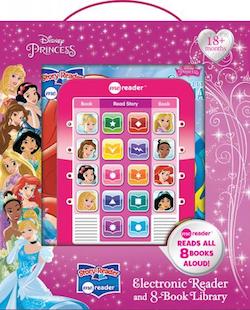 |
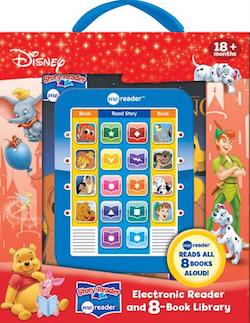 |
Each boxset contains 8 mini 24-page books, each one re-telling a Disney or Pixar movie in a very abbreviated way. Using the electronic pad, the child first selects a book's icon and then they press each page's icon. The book is read to them as they go. Simple matching and/or sequencing skills are necessary, but the book designers were very thoughtful. The buttons are displayed in two columns of 5, and you move down them logically, and each icon has both a unique shape and color.
When my sons beg for a movie, I often offer up suggestions of movies we have Me Reader books for, knowing they are likely to read the books later if I do. For my son Luke, the Me Reader provides sensory enjoyment (Sounds! Buttons!), and he just happens to be functionally interacting with a book. For my other son Harry, it provides endless access to an adult reading a story.
Disney Classic 3" Box: Winnie the Pooh; Peter Pan; 101 Dalmatians; The Lion King; Jungle Book; Finding Nemo; and Aladdin.
Disney Princess 3" Box: Cinderella; Beauty and the Beast; Aladdin; The Little Mermaid; Snow White; Sleeping Beauty; The Princess and the Frog; and Tangled.
There are tons of books that tie-in to existing children's media, but there is something really special about a book you love being made into a gorgeous movie. Magic Light Pictures has bottled that wonder with each loving adaptation of some of Julia Donaldson's best picture books.
Books with stories that rhyme and have repetitive structures are ideal for autistic kids because they allow a child to feel rooted in the narrative and language. Julia Donaldson is one of the best living picture book writers today, and this is her wheelhouse. Her partner in crime, illustrator Axel Scheffler, is a gifted, modern, and very distinctive artist.
My son Harry loves all her books. But for Luke, they are way too long. He really struggles with attention. But he easily conquered that problem for The Gruffalo after he saw The Gruffalo movie, and we have continued to have success with the other Magic Light film adaptations.
The films based on Julia Donaldson's books include The Gruffalo and The Gruffalo's Child, Stick Man, Room on the Broom, and The Highway Rat. You can find all these titles streaming on Netflix or for purchase on other digital media sites. The Highway Rat is a new release, and for now it is only available in the UK.